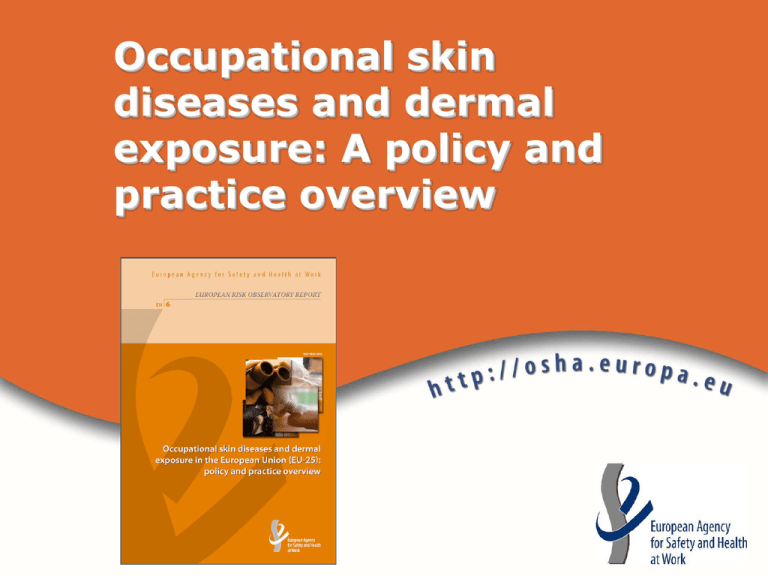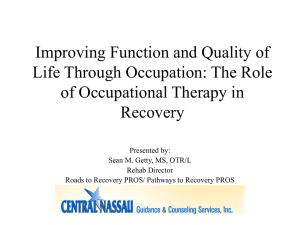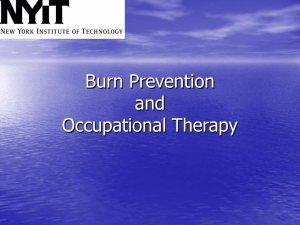Occupational skin diseases and dermal exposure
advertisement

Occupational skin diseases and dermal exposure: A policy and practice overview Occupational skin diseases and dermal exposure Occupational skin diseases are among the most important emerging risks They are most common – after MSDs occupational diseases Examples of sectors and occupations at risk – in Appendix I National polices and practices related to dermal exposure and skin diseases – in Appendix II Recognition of occupational skin diseases European list of occupational diseases – Commission’s Recommendation 2003/670/EC of 19 September 2003 includes a schedule of diseases recognised as occupational in origin Member States determine criteria for recognition of diseases as occupational - national lists may be more or less comprehensive than the European schedule EUROSTAT collects statistical information on occupational diseases, including those affecting skin Incidence rate of occupational skin diseases (EUROSTAT) Disease 2001 % of Inc. occ. rate dis. Contact dermatitis 10.90 Contact urticaria 0.25 Skin cancer 0.01 Total no. of skin diseases 11.20 Total no. of occupationa l diseases 100.00 2002 % of Inc. occ. rate dis. 2003 % of Inc. occ. rate dis. 5.20 10.90 7.40 10.40 7.70 7.80 5.90 6.90 5.50 0.10 0.22 0.03 0.10 0.30 0.02 0.20 0.20 0.02 0.10 0.11 0.02 0.10 0.00 5.30 11.10 7.50 10.70 7.90 8.00 6.00 7.10 5.60 74,90 100.00 78.80 47.10 100.00 67.6. 100.00 2004 % of Inc. occ. rate dis. 73.50 100.00 2005 % of Inc. occ. rate dis. Occupational skin diseases Resemble other skin disease Localised effects Irritation/burns/urticaria – acids, bases, solvents Sensitisation/allergy/phototoxicity – latex, PAH Skin cancer – UV, CrVI Skin infections – fungi, Changed epidermal production – acne – PCB, dioxins Effects of physical agents – heat, cold, radiation Systemic effects Blood disorders – leukaemia - benzene Reported skin problems related to work – by gender and age (EWCS) % of occupational skin diseases - by gender % of occupational skin diseases - by age 0 8 7 2 4 6 15-24 6 25-34 5 4 35-44 3 45-54 2 1 >=55 0 1995 2000 Men 2005 Women All 1995 2000 8 Incidence rate of occupational skin diseases – by sector (EUROSTAT) 0 5 10 15 10,4 Manufacturing 0,9 Cons truction 9,1 2,6 Hotels and res taurants Financial interm ediation 5,9 1,1 0,3 3 Real es tate and bus ines s activities 3,5 Public adm inis tration and defence Education Health and s ocial work Other com m unity, s ocial, pers onal s ervice activities Activities of hous eholds All NACE branches – Total 35 31,5 Mining and quarrying Trans port, s torage and com m unication 30 7,1 Fis hing Wholes ale and retail trade 25 4,1 Agriculture, hunting and fores try Electricity, gas and water s upply 20 0,5 5,1 9,5 0,3 5,3 Dermal exposure Legislation applicable – includes numerous Directives related to dangerous substances – chemical, biological, physical risks No Occupational Exposure Levels Little data related to occupational dermal exposure RISKOFDERM – project aiming at development of tools for assessment of dermal exposure CEN/TS15279 – ‘Workplace exposure – measurement of dermal exposure- principles and methods’ Assessment of the risk of dermal exposure Risk identification process Importance of occupational/employment history, including current exposures Medical examination of the skin Inspection of the workplace Methods of controlling the risk Removal of risk factor- substitution Engineering controls – enclosed systems, automation, ventilation Organisational measures Information and education Personal protective equipment General housekeeping and personal hygiene Conclusions There are differences in national lists of occupational (skin) diseases Collecting of comparable statistical information related to occurrence of occupational skin diseases is very important for evaluation of the scale of the problem Lack of occupational exposure standards and validated methods of assessment of skin exposure are some of the main issues in developing risk assessment models Challenges Uniform framework for recognition and recording of occupational skin diseases needs to be developed Validated models for evaluation of exposure through skin are needed Raising awareness among workers and employers of risks resulting from exposure to chemical, biological and physical hazards is essential to achieve lasting improvement Occupational skin diseases and dermal exposure: More information available at: Agency’s information on dangerous substances http://osha.europa.eu/en/topics/ds Publication: http://osha.europa.eu/en/publications/reports/TE700704 9ENC_skin_diseases/view European Risk Observatory: http://riskobservatory.osha.europa.eu European Agency for Safety and Health at Work: http://osha.europa.eu/ Thank you for your attention!






